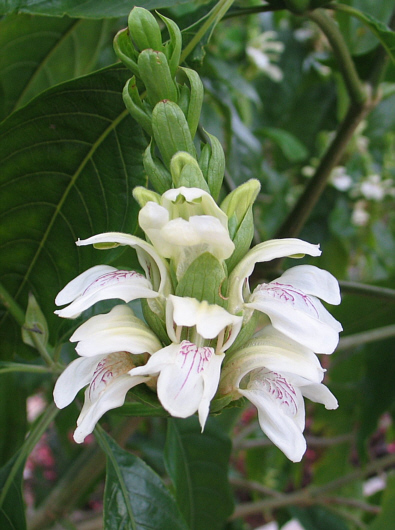

Zitierweise / cite as:
Carakasaṃhitā: Ausgewählte Texte aus der Carakasaṃhitā / übersetzt und erläutert von Alois Payer <1944 - >. -- Anhang A: Pflanzenbeschreibungen. -- Justicia adhatoda L. -- Fassung vom 2007-07-28. -- URL: http://www.payer.de/ayurveda/pflanzen/justicia_adhatoda.htm
Erstmals publiziert: 2007-07-28
Überarbeitungen:
Anlass: Lehrveranstaltung SS 2007
©opyright: Dieser Text steht der Allgemeinheit zur Verfügung. Eine Verwertung in Publikationen, die über übliche Zitate hinausgeht, bedarf der ausdrücklichen Genehmigung des Verfassers
Dieser Text ist Teil der Abteilung Sanskrit von Tüpfli's Global Village Library
WARNUNG: dies ist der Versuch einer
Übersetzung und Interpretation eines altindischen Textes. Es ist keine
medizinische Anleitung. Vor dem Gebrauch aller hier genannten Heilmittel wird
darum ausdrücklich gewarnt. Nur ein erfahrener, gut ausgebildeter ayurvedischer
Arzt kann Verschreibungen und Behandlungen machen!
Falls Sie die diakritischen Zeichen nicht dargestellt bekommen, installieren Sie eine Schrift mit Diakritika wie z.B. Tahoma.
Verwendete und zitierte Werke siehe: http://www.payer.de/ayurveda/caraka0001.htm

Abb.: Justicia adhatoda L. - Indisches Lungenkraut
[Bildquelel. Wikipedia]
Drury:
"Adhatoda Vasica (Nees). Do. Malabar nut, Eng. Adalsa, Arusa, Adarsa, Hind. and Duk. Adatodai, Tam. Adasaram, Tel. Atalotakam, Mal. Arusa, Beng.
Description.—Shrub, 8-10 feet; leaves opposite, lanceolate; corolla monopetalous, irregular; stem much branched; flowers on short spikes, terminal; flower whitish, spotted, sulphur-coloured at the throat, and at the limb with dark purple lines. Fl. Feb. —April.—Justicia Adhatoda, Linn.—Roxb. Fl. Ind. i. 120. ------Peninsula. Bengal. Nepaul.
Medical Uses.—The juice of the leaves is given in a dose of two -drams with one dram of the juice of fresh ginger as an expectorant in coughs, asthma, and ague. They are bitterish and subaromatic, and are administered in infusion and electuary.—(Tourn. Agri. Hart. Soc. of India, x. 28. Ainslie). The leaves, flowers, and root, especially the flowers, are considered antispasmodic, and are given in cases of asthma and intermittent fever. They have also been successfully employed in chronic bronchitis, and other pulmonary and catarrhal affections when not attended with fever.—(Pharm. of India. Ind. Annals of Med. Science., x. 156.) The leaves are given to cattle as medicine, and to man for rheumatism. The fresh flowers are bound over the eyes in cases of ophthalmia.—(Stewart's Punj. Plants.) The leaves are given in conjunction with other remedies by the native doctors internally in decoction, as anthelmintic.—Ainslie. Roxb."
[Quelle: Drury, Heber <1819 - 1872>: The useful plants of India : with notices of their chief value in commerce, medicine, and the arts. -- 2d ed. with additions and corrections. London : Allen, 1873. -- xvi, 512 p. ; 22 cm. -- s.v.]